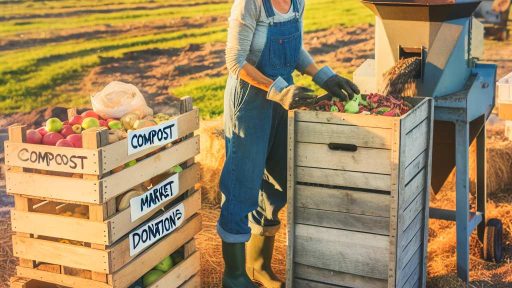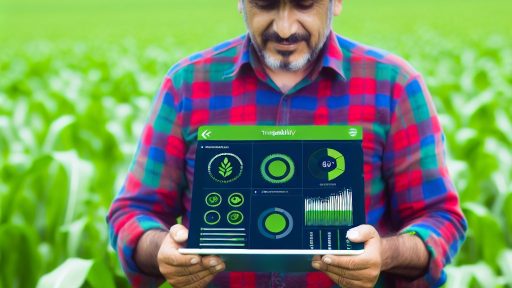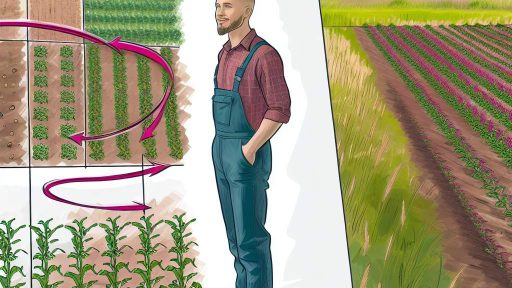Introduction to Farm-to-Table Concept and its Growth in the USA
The farm-to-table concept connects consumers directly with farmers.
This approach emphasizes the importance of local sourcing and seasonal ingredients.
Recently, farm-to-table initiatives have surged in popularity across the United States.
Understanding the Farm-to-Table Philosophy
Farm-to-table promotes the use of locally produced food.
This movement supports sustainable farming practices and reduces food miles.
Consumers increasingly seek fresher and healthier food options.
Consequently, the demand for local produce and meats dramatically rises.
The Rise of Pop-Up Events
Farm-to-table pop-ups exemplify this growing trend.
These events offer unique dining experiences while highlighting local ingredients.
Furthermore, they create a direct connection between chefs and farmers.
Pop-ups often serve as a powerful marketing tool for rural farmers.
Impact on Rural Farming Economies
Farm-to-table pop-ups significantly boost rural economies.
They allow farmers to showcase their products to a wider audience.
Additionally, these events foster relationships between consumers and producers.
This collaboration encourages community support for local agriculture.
Transform Your Agribusiness
Unlock your farm's potential with expert advice tailored to your needs. Get actionable steps that drive real results.
Get StartedUltimately, the farm-to-table movement promotes economic resilience in rural areas.
The Role of Pop-Up Restaurants in Promoting Local Produce
Creating Direct Connections
Pop-up restaurants forge direct connections between farmers and consumers.
These temporary venues highlight local produce in exciting and unique ways.
Consumers enjoy fresh, seasonal offerings that reflect their local community.
Farmers benefit by showcasing their products to a wider audience.
Encouraging Community Engagement
Pop-up events facilitate community interaction and engagement.
Local chefs often collaborate with farmers to create special menus.
This collaboration deepens the community’s appreciation of local agriculture.
Moreover, it fosters a sense of pride among residents for their local farmers.
Supporting Economic Growth
Pop-ups promote economic growth in rural areas.
They often attract visitors who spend money at local businesses.
Restaurants stimulate demand for fresh produce, benefiting local farmers.
This creates a ripple effect, bolstering the regional economy.
Promoting Sustainable Practices
Many pop-up restaurants use sustainable practices in their operations.
They often focus on reducing food waste and utilizing local resources.
This approach encourages consumers to prioritize sustainability.
As a result, it helps cultivate a culture of responsible eating.
Increasing Visibility for Local Farms
Pop-up restaurants provide an excellent platform for local farms to gain visibility.
Farmers can share their stories and practices with the public.
This openness promotes transparency in the food system.
Additionally, it helps educate consumers about where their food comes from.
Economic Benefits of Farm-to-Table Pop-Ups for Rural Farmers
Boosting Local Sales
Farm-to-table pop-ups create direct sales opportunities for rural farmers.
These events allow farmers to reach consumers without intermediaries.
As a result, profits from sales remain within the local community.
Showcase Your Farming Business
Publish your professional farming services profile on our blog for a one-time fee of $200 and reach a dedicated audience of farmers and agribusiness owners.
Publish Your ProfileFarmers can set fair prices that reflect their hard work and investment.
This approach enhances the local food economy significantly.
Enhancing Market Visibility
Pop-up events increase visibility for local farmers and their products.
Consumers become familiar with specific farms and their offerings.
New collaborations often emerge from these events between farmers and chefs.
Farmers can showcase their unique produce, which attracts attention.
This exposure can lead to long-term customer loyalty.
Strengthening Community Connections
Farm-to-table pop-ups foster connections between farmers and community members.
People appreciate knowing where their food comes from and the people behind it.
These events encourage conversations about local agriculture and sustainability.
Additionally, they support a sense of place and belonging within rural communities.
This shared experience can build greater support for local farming initiatives.
Driving Innovation and Growth
Pop-ups inspire creativity among local farmers and chefs.
They often experiment with unique recipes and seasonal ingredients.
This culinary innovation showcases the diversity of local produce.
Furthermore, farmers can receive feedback directly from consumers.
This insight can guide better crop planning and development.
Stimulating Increased Tourism
Farm-to-table events can attract visitors from outside the region.
Tourists seek authentic experiences linked to local food cultures.
This influx can benefit adjacent businesses, such as lodging and retail.
Farmers’ markets draw attention to the rural charm of their locations.
In turn, this boosts the overall economy of the community.
Explore Further: Biodiversity in Farming for Agroforestry Integration
Community Engagement and Awareness through Pop-Up Events
The Role of Local Events
Local pop-up events connect communities with nearby farmers.
These events create awareness about the importance of local produce.
Moreover, they stimulate interest in sustainable agricultural practices.
Building Relationships Between Farmers and Consumers
Pop-ups provide a platform for direct interaction.
Consumers can ask questions and learn about farming practices.
This transparency fosters trust between farmers and consumers.
Highlighting Local Ingredients
Events often showcase seasonal and locally-sourced ingredients.
Attendees can enjoy unique dishes prepared with fresh produce.
This highlights the uniqueness of regional flavors.
Engaging Activities and Education
Pop-ups frequently offer cooking demonstrations and workshops.
These activities educate attendees on food preparation techniques.
Additionally, they promote the nutritional benefits of local foods.
Fostering Community Partnerships
Collaboration between local businesses boosts community ties.
Restaurants, farmers, and artisans come together during these events.
This cooperation enhances marketing efforts for local products.
Impact on Rural Economies
Pop-up events stimulate local economies by attracting visitors.
They create new sales avenues for farmers and local businesses.
Showcase Your Farming Business
Publish your professional farming services profile on our blog for a one-time fee of $200 and reach a dedicated audience of farmers and agribusiness owners.
Publish Your ProfileAs a result, rural areas experience economic revitalization.
Creating Lasting Impressions
These events leave a positive impact on the community.
Attendees often return for future events, fostering loyalty.
Ultimately, they cultivate a culture of support for local farming.
You Might Also Like: Farm-to-Restaurant Programs for Heirloom and Heritage Crops
Case Studies of Successful Farm-to-Table Pop-Ups in Rural Areas
Highlighting Local Farmers
Many farm-to-table pop-ups showcase local farmers’ produce.
For example, the Green Plate Project in Vermont sources ingredients from nearby farms.
This direct relationship increases farmer visibility and strengthens the community connection.
Indeed, it creates a marketplace for fresh, local ingredients.
Encouraging Community Involvement
Pop-ups often engage local residents in diverse ways.
They provide opportunities to attend cooking classes and tasting events.
For instance, Harvest Feast in Indiana invites community members to participate in their pop-up dinners.
This involvement fosters a sense of ownership and pride among local residents.
Supporting Economic Growth
These events contribute to the local economy significantly.
By sourcing ingredients locally, they reduce transportation costs.
Consequently, money stays within the community, supporting local businesses.
Moreover, pop-ups create jobs and seasonal employment opportunities.
Promoting Sustainable Practices
Farm-to-table pop-ups emphasize sustainable farming practices.
For example, the Prairie Kitchen Initiative in South Dakota incorporates ethical sourcing.
This commitment resonates with health-conscious diners seeking quality food.
Furthermore, it encourages farmers to adopt environmentally friendly methods.
Establishing Networking Opportunities
These pop-ups create vital networking opportunities for farmers.
Farmers meet chefs and restaurateurs who share their values.
Such connections can lead to long-term partnerships.
Consequently, it facilitates collaborative events and specialized offerings.
Creating Culinary Experiences
Pop-ups offer unique culinary experiences that celebrate local flavors.
Events like the River Valley Dinner Series in Wisconsin feature themed menus.
This focus highlights seasonal produce and regional dishes.
Moreover, it attracts food enthusiasts from urban areas, boosting tourism.
Champions of Grassroots Movements
Farm-to-table pop-ups often serve as champions of grassroots movements.
Their initiatives can influence local policies towards supporting agriculture.
Advocates often promote food transparency and fair practices.
Such advocacy can lead to positive changes in the food landscape.
Discover More: Permaculture Practices for Organic Crop Rotation Systems

Challenges Faced by Rural Farmers in the Pop-Up Model
Market Accessibility Issues
Rural farmers often struggle with limited access to local markets.
This limits their ability to sell directly to consumers.
Additionally, transportation costs can be prohibitively high.
Many farmers lack reliable transportation options.
Therefore, they find it challenging to reach pop-up events.
Financial Constraints
Financing remains a significant barrier for rural farmers.
Showcase Your Farming Business
Publish your professional farming services profile on our blog for a one-time fee of $200 and reach a dedicated audience of farmers and agribusiness owners.
Publish Your ProfileStart-up costs for pop-up events can deter many participants.
Additionally, farmers often face cash flow issues during off-seasons.
Limited access to credit further complicates their financial situation.
Logistical Challenges
Coordinating logistics for pop-up events can be demanding.
Farmers must manage harvesting and preparation schedules effectively.
Unpredictable weather conditions can disrupt plans significantly.
Moreover, sourcing necessary supplies can be difficult.
These challenges require careful planning and flexibility from farmers.
Competition with Established Businesses
Rural farmers often compete with established businesses in pop-up events.
These businesses may have more resources and experience.
Additionally, they might offer a more extensive range of products.
This competition can overshadow the unique offerings of local farmers.
Consequently, farmers need effective marketing strategies to stand out.
Seasonal Limitations
Seasonality heavily influences the availability of fresh produce.
Farmers depend on specific growing seasons to supply pop-up events.
This reliance can limit participation during colder months.
Farmers must manage their crops carefully to align with demand.
Thus, they face significant challenges during off-peak seasons.
Delve into the Subject: Urban Farming and Vertical Gardening for Maximum Space Utilization
Sustainability and Environmental Impact of Farm-to-Table Practices
Benefits of Local Sourcing
Farm-to-table practices promote local sourcing of ingredients.
This approach reduces transportation emissions significantly.
It also supports local farmers, strengthening rural economies.
Minimizing Waste
Farm-to-table initiatives focus on minimizing waste.
Restaurants often use seasonal produce, leading to efficient use of ingredients.
Additionally, any food scraps can be composted, enriching local soil.
Enhancing Soil Health
Sustainable farming methods focus on enhancing soil health.
Practices like crop rotation improve nutrient availability.
Healthy soil encourages biodiversity and supports ecosystems.
Supporting Biodiversity
Farm-to-table operations often prioritize biodiversity.
Diverse crops promote a richer agricultural system.
Moreover, this variety helps protect against pest outbreaks.
Community Engagement
Engaging the community is vital in farm-to-table practices.
Local pop-ups foster connections between consumers and producers.
This builds awareness and appreciation for sustainable farming.
Future Trends for Farm-to-Table Initiatives and Their Impact on Rural Economies
Growing Consumer Awareness
Consumers increasingly prioritize local produce and sustainable practices.
This trend creates demand for farm-to-table initiatives in various communities.
Moreover, awareness campaigns educate consumers about the benefits of local food.
Consequently, more people choose to support local farmers and businesses.
Technology Integration
Advancements in technology are revolutionizing the farm-to-table movement.
Farmers use apps to connect directly with consumers, enhancing sales opportunities.
Showcase Your Farming Business
Publish your professional farming services profile on our blog for a one-time fee of $200 and reach a dedicated audience of farmers and agribusiness owners.
Publish Your ProfileAdditionally, online marketplaces offer platforms for farmers to showcase products.
As a result, access to fresh produce improves in urban areas.
Collaboration Among Stakeholders
Collaboration between farmers, chefs, and local organizations is vital.
Partnerships often establish farmers’ markets and seasonal events.
These collaborations help promote local cuisine and culture.
Furthermore, they strengthen community bonds through shared experiences.
Policy Support and Funding
Government initiatives increasingly support farm-to-table programs.
Grants and subsidies encourage sustainable farming practices.
Additionally, policies that promote local food systems are on the rise.
This support helps bolster rural economies through job creation.
Education and Accessibility
Education plays a crucial role in the success of farm-to-table initiatives.
Schools are incorporating farm-to-table lessons into their curriculum.
This education fosters a new generation of informed consumers.
Moreover, community workshops teach cooking with seasonal ingredients.
Emerging Trends and Innovations
Emerging trends include vertical farming and urban agriculture.
These innovations create new opportunities for local food production.
Furthermore, chefs experiment with farm-to-table menus to engage diners.
This approach cultivates a deeper appreciation for local farmers.
Long-term Economic Impact
Farm-to-table initiatives significantly influence rural economies.
They help improve local food security and reduce transportation costs.
Additionally, increased farm sales directly benefit rural economies.
These initiatives contribute to the sustainability of local farms.
Additional Resources
The Path to Rural Resilience in America – Center for American …




